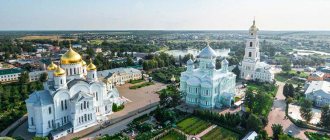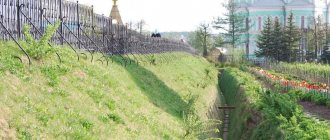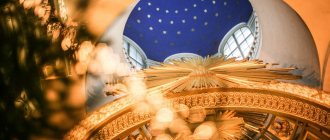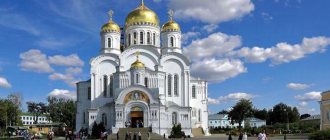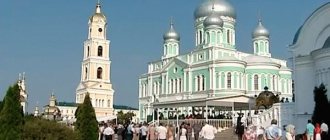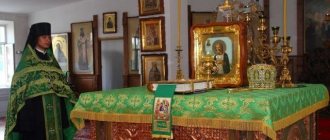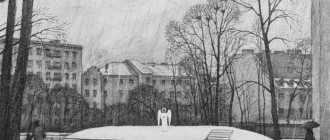Diveevo! Few Orthodox believers do not know the name of this village in the south of the Nizhny Novgorod region. Pilgrims from all over the world flock here to touch the shrines and ask for intercession and help from the almighty. This is such a deep place that it is not for us, bad and sinful, to talk about it. Frankly, it took us a long time to gather our courage before opening an empty computer file and starting to write these lines. In this article we will tell you how to get to Diveevo, what you should have with you, and give tips that will help make your trip as complete and useful as possible.
Where is Diveevo located? How to get there
It is best to consider Nizhny Novgorod . The distance from it to the village of Diveevo is about 170 kilometers. It all depends on which area of the city you are coming from. We counted from the Moskovsky station.
You can also get from Moscow to Diveevo It's better to hit the road in your own car. The road will pass through Vladimir and Murom. Its length will be 450 kilometers. It’s a bit far, but if you go for a few days, then this is the best option. The main thing in this case is the lack of connection to transport. You can come and go whenever you want. At the same time you can go around the surrounding area. For example, stop by Arzamas or Bolshoye Boldino, where the house-museum of A.S. Pushkin is located. We're not even talking about visiting Vladimir and Suzdal. This way you can have a great interesting trip. A real journey. We are sure it will be remembered for a very long time.
Those who are going to Diveevo by car should be pleased with the availability of free parking on the territory of the monastery. A little further in the text there will be a large map of the territory - there you will see where the entrance to the parking lot is located.
For those who come from very far away, you can get to Nizhny Novgorod. Next, take a regular bus. Buses to Diveevo depart from the TRC Nebo bus station almost every hour (the route is called “Nizhny Novgorod - Sarov”). Travel time is 3 hours 20 minutes. You can buy a bus tour to Diveevo in advance.
Diveyevo Monastery was built closer to the second half of the 18th century
The monastery was built closer to the second half of the 18th century. In 1758, a wealthy landowner from Ryazan, Agafya Melgunova, came to Kyiv. When she was young, she lost her husband, and then made a vow to God that she would devote her life to Him. In the Kiev-Florovsky Monastery she accepted the monastic feat with the name Alexander.
In 1758, a wealthy landowner, Agafya Melgunova, came to Kyiv. She lost her husband when she was young, and then made a vow to God that she would dedicate her life to Him.
One day she had a vision from the Most Holy Theotokos, who told her:
“This is I, your Lady and Lady, to whom you always pray. I have come to tell you My will...” She told Alexandra that she did not want her to die in this place. The Queen of Heaven ordered her to go to the place where she indicated, so that there she would end her earthly journey. “...And there will be a place where I will show you to end your godly life, and I will glorify My name there, for in your place of residence I will establish My great abode. Go, My servant, on the way, and may the grace of God, and My strength, and My grace, and My mercy, and My mercies be with you!”
One day Agafya had a vision from the Most Holy Theotokos, who ordered her to leave the monastery and follow where She indicated. The
elders of the Kiev Pechersk Lavra accepted the words from the mother’s vision, and with their blessing Alexandra set off on her journey. When mother was walking from Murom to the Sarov Hermitage, she passed by the village of Diveevo and decided to stop there to rest. Here the Mother of God appeared to her and said that this was the very place where she needed to stay.
What to take with you to Diveevo
This list is compiled based on our own “punches”. We got together somehow spontaneously and went completely unprepared, so we experienced some, to put it mildly, inconveniences. I hope our list will help you make your trip more comfortable and rewarding.
- Cash. Our whole problem was that we only had small change in cash. Having relied on plastic cards, we were horrified to discover that they were not accepted on the territory of the monastery. There is absolutely no time to run around and look for an ATM to get cash during an excursion. Money is needed, for example, to buy candles, give notes, and just to have a snack.
- Text of the prayer: “ O Mother of God, Virgin, rejoice. Blessed Mary, the Lord is with you. Blessed are You among women and blessed is the Fruit of Your womb, for You have given birth to the Savior of our souls .” Learn it in advance or print it on a small piece of paper as a cheat sheet. Have it with you. Why, more on that later.
- Beads. Do you know what this is? If not, then this is a thread with beads like a bracelet or necklace. There should be 30 or 50 beads. Again, why? Do not hurry. We'll explain in due time. For now, just put it in your bag. If not, buy it at any church store. It will come in handy.
- Again, without further explanation, we recommend taking several bags with you. Not big ones, but very small ones, in which they sell loaves in stores.
- Swimming trunks for men and nightgowns for women. This is in case you decide to swim in the holy springs. Even if right now, as you read these lines, you are not going to swim, still take your swimwear. Anything can happen, suddenly you want it, but there’s nothing to it. Of course, you still need to grab towels.
- Containers for holy water. There are no special restrictions here. You can take at least a 10-liter bottle.
What and why is needed will become clear later in the text. In principle, almost all of these things are sold in numerous shops right on the spot. But why, say, buy swimming trunks if you already have 3-4 pairs. The same goes for nightshirts, water bottles and other things.
Bus tour Nizhny Novgorod - Diveevo begins
The cost of the excursion for an adult is 1100 rubles. For a child - 800-900 rubles. The program includes visits to Diveevo and Arzamas. Arzamas is located along the way, so it would be wrong not to stop by for an hour and a half. Although, there is a route only to Diveevo.
Our excursion bus departed at 9.00 from Lenin Square. When boarding the bus, everyone was told where they were sitting. Naturally, we got seats on the sunny side. Before we could start to get upset, the driver closed the doors and the car set off. Looking around, we were delighted to find that the last row of seats (our favorite seats) was completely empty.
It was just luck that the bus was half empty. Otherwise we would have been roasting in the sun all the way. So let me give you one more piece of advice. If you are traveling to Diveevo from Nizhny Novgorod in the morning, it is better to take seats on the right side of the bus. It’s just amazing, but no one else moved to the right except us. Why?
Just a few words about the group. When our lady guide started asking who was from where, we were surprised to discover that there were only four Nizhny Novgorod residents on the bus. The remaining participants came, without exaggeration, from all over the country and even from abroad. There was a couple from Vladivostok, two ladies from Kyiv, someone from the Stavropol region, a small group from Pskov. We didn’t remember everyone, but as you can see, the geography is impressive.
A pilgrimage tour to Diveevo is a very special event. Here they don’t quarrel with each other about seats on the bus, don’t push each other while boarding, don’t speak loudly, don’t laugh at the top of their lungs, and don’t pester neighbors with all sorts of empty talk. The environment is calm and focused. This is understandable. We are not going to some rodelbahn in Gorokhovets, not to the underground speleology museum in Peshelani, or even on a sightseeing tour of Nizhny Novgorod. We have a meeting with a special place ahead. We must behave accordingly.
Go. The bus taxied onto the metro bridge and rushed across the Oka River. Suddenly I thought that now people from other cities are looking at Nizhny Novgorod, getting to know it, making some kind of first impression. We tried to look at the city through the eyes of a guest. Here's what we got:
The bus rushed along the new metro bridge, rose to the upper part of the city, then drove along Gagarin Avenue towards the Shcherbinki-II microdistrict. I think the guests must have liked what they saw. Especially if someone came from a small town. Of course, it was impossible to say that we felt proud of our city. Fortunately, the guests did not see any old “bedbug infestations” in the vicinity of the station or the backwaters of other outlying areas. Otherwise, we would definitely have collapsed from shame.
When we left the city and drove along the Arzamas highway, the guests could witness large-scale road construction. So large that a temporary bypass road was built to bypass the problem area. On the main highway, a unique job was carried out to compare relief convexities.
Hills that were too high were “cut off”, and lowlands that were too deep were filled with soil. For what? So that in winter loaded trucks can have a chance to “pull” their cargo up a high slope and not accelerate too much on sharp descents:
The rest of the road here is quite good. There is only one big BUT. There are very few gas stations on the Arzamas highway. Very! Therefore, if you drive your own car, try to refuel in advance so as not to spoil your nerves.
After about an hour and a half of travel, a sanitary stop awaited us. The roadside complex "Caramel", which does not reach the city of Arzamas, hospitably opens the doors of a cafe, motel, toilets and even a laundry room with a shower to everyone passing by. Since the stop lasted only 15 minutes, we, naturally, did not take a shower, but we had the happy pleasure of admiring the building of the complex itself.
We have always liked architectural solutions that greet visitors with welcoming “faces” from afar. When building the “Caramel” complex, the architects decided to increase the impact on travelers and designed this “friendly” façade:
And at night they also glow! Horrible! Can you imagine what it will be like for a “tired traveler” to find himself face to face with the façade of the “Caramel” complex?
Letting us off the bus, the guide said that the cost of a taxi fare from here to the village of Diveevo was 2,000 rubles. By doing this, she made it clear what would happen to those who did not return to the bus within the allotted 15 minutes. Looking ahead, we would like to say that on pilgrimage tours people behave more responsibly. During the entire excursion, no one was late for the bus.
As a contrast: when we were on a bus tour of Kazan, one couple decided to leave the tour altogether at the next stop. It would seem that it’s their business, let them blame all four. But if they had at least warned about this. For about 30 minutes, the rest of the participants sat on the bus, and the guide tried to find slobs at the next object. Only later, when they got through to them through the travel agency, it became clear that they just up and left. Well done! That's how it should be!
Then our bus took us through the city of Arzamas. On the advice of the guide, we decided to go to Diveevo first, and then on the way back to see the cathedrals of Arzamas.
And then, 3 hours after leaving, we found ourselves at the destination of our trip.
Holy Trinity Seraphim-Diveevo Monastery
The very first thing our lady guide did was stop the group at a large map of the monastery. Within a few minutes, she showed us all the most important objects and indicated the collection time after visiting the monastery.
If you are also planning to go to Diveevo, then here’s
monastery (2.3Mb). You can download it and take a closer look.
The excursion program did not include organized group visits to temples and other sites. In fact, we were given time so that everyone could spend it as they saw fit.
However, in the allotted two and a half hours it was worth doing the following things:
- venerate the relics of Father Seraphim,
- walk along the groove of the Blessed Virgin Mary,
- collect holy land.
It just seems to you that all this can be done in half an hour. Real life is much richer than our wildest assumptions. Our plans can be adjusted at any time, and all we have to do is carry out whatever the higher powers desire. Our group was very lucky. I hope you have good luck too.
Many people who have never been to Diveevo wonder along the way: what is it like, the Seraphim-Diveevo Monastery? What will we see when we enter the territory? How do you generally behave so that you don’t get reprimanded?
Upon entering the gate, you will see this panorama:
On the left is the pilgrim's house. In simple terms, this is a hotel for those who come to the monastery for a few days. According to reviews, the hotel is very worthy. The rooms are warm, with all amenities and modern furniture. Surprisingly, but true: there is a bar on each floor, and there is a cafe in the basement. All this is in stark contrast to other pilgrimage centers with old, creaky beds and courtyard amenities.
There is a free parking lot in front of the pilgrim's house. The main advice is to book your rooms in advance. There are enough people who want to live on the territory of the monastery. Phone for booking: +7 (83134) 4-34-45, +7(83134)3-00-23.
To the right are two yellow and one blue buildings. The novices of the monastery live here - tourists are prohibited from entering there.
To the right you will see a high bell tower and the Kazan Cathedral:
It is there, in the arch of the bell tower, that the bulk of the monastery’s visitors head.
In the village of Diveevo, Agafya tripled the foundation of the Kazan Church with her own funds
Afterwards, in Diveevo, Mother Alexandra tripled the foundation of the Kazan Church near the Stefanovskaya Church, erected at her own expense. The temple was consecrated in 1780 by the builder of the Sarov Hermitage, Pachomius.
The temple had two chapels, one of which was consecrated in honor of St. Nicholas, and the other in honor of the first martyr Archdeacon Stephen.
The Kazan church was a parish church, but Father Seraphim always said that it would be a monastery cathedral.
“The Kazan Church, my joy, there will be such a temple as there is no other like it...”
- said Father Seraphim. Mother Alexandra, on the advice of the Sarov elders, asked a local landowner for several seedlings of land that was located close to the Kazan Church. A house was built on this land where mother lived with four novices. This community became known as Kazan. The sisters lived there according to strict rules.
Kazan Church in Diveevo, where the Kazan community was organized
In 1789, care of the community was given to the young hierodeacon Seraphim. Soon abbess Anastasia Kirillovna died, and Ksenia Mikhailovna was installed as abbess.
By 1826, the number of sisters in the community began to increase. Ksenia ruled for 43 years; during her reign, memories were preserved of difficult but selfless work. The Venerable Seraphim of Sarov himself spoke about her: “The great servant of God...a spiritual scourge...”.
Trinity Cathedral. How to properly venerate the relics of Seraphim of Sarov
Incredible, but true: the queues to the Trinity Cathedral can amaze the imagination. The guide said that the longest time she and her group spent in line to see the relics of St. Father Seraphim was 6 hours (SIX HOURS!!!).
On our previous visits to Diveevo, we ourselves saw large lines of people who were patiently waiting for their chance to touch the shrine. Probably, only true believers who come from very far away will be able to withstand such a test. Ordinary tourists traveling for purely educational or entertainment purposes will not bother themselves.
As the guide said, she usually takes on the difficult task of standing in line, letting the group go to do other things, coming up from time to time and checking her turn.
When we arrived, a crowd of about 200 people was swaying in front of the entrance. According to the guide, one could say that “there was no queue at all today.” The estimated wait time to enter the Trinity Cathedral turned out to be approximately 20-30 minutes. The lady guide told us to wander around the area for now and after 20 minutes we would gather here at the entrance. She herself remained to guard our place.
After the specified time, we gathered at the entrance. The line really moved forward and we found ourselves almost at the gate to the temple:
It seemed that we were almost at the goal, if I may say so. But, as mentioned earlier, life is richer. When there were only a few people left in front of us, the gates of the cathedral were closed for cleaning. We had to “walk” for another half hour. The guide stayed in line again so that we wouldn’t have to stand in it again later.
A few words about the queue itself. People do not stand in a chain one by one. This is understandable - then the line of pilgrims would stretch to the entrance to the monastery territory. Imagine a line of soldiers with about five people in each row. This is what the queue to the cathedral looked like. Only here, of course, there were no straight rows and columns.
The people gradually moved forward, but no one pushed, no one tried to get forward. At the gate the queue became a little narrower - about 2-3 people in a row, and people approached the shrine with relics one at a time. Therefore, the queue goes quite slowly at the very end and gets faster as it approaches the entrance to the cathedral.
The conversations of pilgrims are also significantly different from the gossip that can be heard in a regular queue. No one talked about politics, their illnesses, or discussed medicines or gardening problems. Mostly people stood silently, and those who spoke quietly discussed only topics related to religion. At least we didn’t hear any other conversations.
On the approach to the cathedral there is a small kiosk where you can submit notes - requests, order commemorations, masses, memorial services and other similar things.
Here are the prices:
But then the gates opened again and it was our turn.
The revival of the monastery in Diveevo began in 1998
The revival of the monastery began only in 1998. The Kazan Church of the Icon of the Mother of God was consecrated. In 1989, the Trinity Cathedral was transferred to the community. Its consecration took place on March 31.
In 1991, the Holy Synod decided to get serious about the revival of the monastery. In the same year, the relics of Seraphim of Sarov were brought to the monastery. Currently, many pilgrims come to the relics of the saint.
Currently, in the monastery, in the village of Diveevo, there are the relics of St. Seraphim of Sarov
On June 1, 1993, the church was re-consecrated in honor of the Nativity of Christ. In 1995, the Kazan Church was given the status of an architectural monument of federal significance. The church in honor of Mary Magdalene was also put in order and repaired. Under her, a monastery Orthodox school was opened.
Church in honor of Mary Magdalene in the village of Diveevo. An Orthodox school was opened under her
In 2000, the relics of Alexandra, Martha and Elena Diveevsky were found in the monastery. A little later, they were glorified as locally revered saints of Nizhny Novgorod. In 2002, research was carried out in the Kazan Church, which required restoration work.
Work began only in 2003. In the same year, in honor of the 100th anniversary of the canonization of Seraphim of Sarov, the service was performed by His Holiness Patriarch of Moscow and All Rus' Alexy II. The future patriarch, Kirill Gundyaev, was also here.
How to properly venerate the relics of Seraphim of Sarov
Good for believers. They know the rules and do everything as expected. But if a simple person approaches a shrine, his actions may be clumsy. This will make both himself and the people around him feel awkward. To avoid embarrassment, it is enough to know how to apply the relics correctly.
Two bows, they touched the cloth cape with their lips or cheek, another bow, they walked away. If in doubt, watch how other people do it.
It would seem that everything is quite simple. But in the temple you can get confused, worried and mess up something. Therefore, while you are standing in line, you can mentally perform these simple steps. If you have a pectoral cross, you need to pull it out from under your clothes. When you venerate the relics, the cross will certainly touch the reliquary and will be considered consecrated. If you want to consecrate other things - wedding rings or something like that, give them to the minister before adding them to the relics. She will do everything right. Do not attempt this step yourself. You all don't know how to do it early!
Unfortunately, at the shrine with the relics of Seraphim of Sarov we are faced with two directly opposite rules: on the one hand, one must venerate the relics thoughtfully, without fuss. On the other hand, it is also somehow impolite to linger at the shrine for a long time. After all, there is a considerable queue behind you. Some came from the other side of the country or even from abroad.
What to do?
I don’t know if this is the rule, or if we were somehow especially lucky, but in the afternoon at the entrance to the cathedral one could see this picture:
Look: no one! NOBODY!!! There is usually a long queue here. Where the canopy ends is the cathedral gate (on the right). They are open. So the cathedral is open. That is, if we had not tried to immediately go into the cathedral, but had done it later, then we would not have had to stand in line at all, or rush, performing the ritual at the relics. As they say, if only I had known in advance.
You are not allowed to take photographs inside the cathedral itself. Therefore, we cannot show you photos of the interior decoration. The personal belongings of St. Seraphim are especially revered. His shoes, his clothes, even his hoe. All this lies in glass cases to the left of the shrine with the relics. Many people don't even know that these items are here. They are also shrines worshiped by the Orthodox.
To the right of the shrine there is a small icon - the same one that Father Seraphim himself prayed to. There is also a queue for her. People ask her for help in their affairs. There is a misconception about how to make requests to an icon. It is believed that one must mentally say the request while standing right in front of the icon, then bow, venerate and move away.
For this reason, many people linger at the icon for a long time, creating a queue.
How to? You really need to mentally say your request. But you can do this on the way, while still standing in line. When approaching the icon, you need to make two bows, kiss your lips or forehead, bow one more time and move away. Under no circumstances should you touch sacred objects with your hands!
In total, we spent about 10 minutes in the Trinity Cathedral. It was possible to stay longer, but there was another action next, which is also a must when visiting Diveevo.
With the blessing of Seraphim of Sarov, the Mill Community was built
Next to the Kazan community, with the blessing of Seraphim of Sarov, the Mill community was built. The mill community was founded on December 21, 1826, on the day of the feast of the conception of Righteous Anna.
Next to the Kazan community, with the blessing of Seraphim of Sarov, the Mill community was built
The first mentor of the community was a girl from a noble family, Elena Manturova. Her brother invested his funds for the construction of a two-story stone church in the name of the Nativity of Christ near the porch of the Kazan Church. Below, a temple was built in the name of the Nativity of the Blessed Virgin Mary.
And in the future, the community was monitored by Manturov, the brother of the mentor of the Mill community. In gratitude for his recovery from a serious illness, he made a vow of poverty until his death.
The land on which the Mill community stood belonged to the Batashevs. One of the heiresses promised Father Seraphim to give this land, accepting it as her inheritance. A little later, a formal order came to donate this land.
1839
this year Ksenia Potkhina became the head of the Mill community
The last head of the Mill community was Ksenia Potkhina, who was elected in 1839. After the death of St. Seraphim of Sarov, the two communities were united into Seraphimodiveevo. The Kazan church began to exist separately from the community.
Canal of the Blessed Virgin Mary
Surely many have heard this name, but... what kind of groove is this? how does she look? Why is it so revered among Orthodox Christians?
On November 25, 1823, the Mother of God appeared to Father Seraphim. The Mother of God showed him the place in Diveevo where he needed to build a monastery, and ordered him to surround it with a ditch and a rampart. Thanks to this event, the Diveyevo Monastery was created. The groove of the Virgin Mary is a broken line, an open heptagon with a symbolic length of the sides - 777 meters.
During the life of Father Seraphim, 6 sides were dug. The last one was completed after his death. It is believed that when the Antichrist comes, he will pass everywhere, but will not jump over the grooves.
Let's see what the groove of the Most Pure Queen of Heaven looks like:
The groove is on the right. Do you see the green spacers? Apparently they keep the banks from crumbling. Along the shaft along the groove there is a path fenced with a fence.
How to correctly walk the Canal of the Virgin Mary?
Scroll back and look at the text of the prayer “O Theotokos, Virgin, Rejoice...”. Walking along the path at the top of the shaft, you must say this prayer 150 times (one hundred and fifty times). If you do everything as expected, then passing the Holy Canal takes about 40 minutes. People here walk slowly, intently reciting a prayer.
But how not to lose count? It’s only at the very beginning that you can bend your fingers and count “times” to yourself. But no longer in your third or fourth decade, you will most likely begin to get confused. As a result, you will, of course, pass the groove, but not being sure of the accuracy of the calculation, you will be immersed in heavy thoughts that you did everything wrong.
Rosary beads help. Do you know what this is? Yes, here they are:
We are ashamed to admit our ignorance, but previously we had never understood the purpose of this item. It was obvious that he had something to do with religion. There is even an expression: “to pray while fingering the rosary.” But we didn’t understand why we were going through them.
The excursion to Diveevo filled the knowledge gap. It turns out that rosaries are needed precisely in order not to lose count when reading prayers. After all, many prayers must be said more than once. After each repetition, we “shift” the next bead on the bracelet. And so on until they are all over.
Of course, it is not necessary to have a rosary with 150 beads. It is enough for there to be 30 or 50 of them. Then you will have to make, respectively, 5 or 3 circles around the bracelet. But this is still much easier than trying to count in our mind how many times we have already said the prayer and how many are left.
Pay attention to how much the rosary costs in the monastery. You can buy them in advance at any church store. It will cost less. Although... you might want to have rosary beads from Diveevo. Then get your fat wallet ready. You see the price. Please note that plastic cards are not accepted here.
In light of the described rule for passing the groove of the Virgin Mary, it no longer seems surprising that people walk along it slowly, as if immersed in a light trance. After all, if you walk quickly, the path will end before you have read the prayer the prescribed 150 times. And you are not supposed to go to the second round.
It's actually very good that the groove is divided into 7 sections. This helps you maintain the correct walking pace. After completing the first segment, you should have the prayer read 21 times. If you don’t have time, you can slow down and even stop altogether, as many do.
Let's see some more photos of the Heavenly Queen Groove:
The most amazing and unexpected thing: behind the fence of the monastery, despite all this, the most ordinary life goes on. Children go to school, some ride bicycles and scooters. Talking loudly. Here's one who rode a hoverboard. All this happens very close. Local residents are probably so accustomed to being next to a monastery known throughout the world that they do not attach much importance to it.
At the same time, even in our group there were people from Vladivostok! They flew almost 7,000 kilometers to walk along Our Lady's Canal. And some come from abroad! Still, life is not quite fair. Those who “need” are forced to endure enormous inconveniences and difficulties in order to get what they want. Others, who either “don’t need it at all” or “don’t need it that much,” walk by every day and don’t even notice.
Of course, one could write beautifully about how God sends us such trials, only true believers will overcome obstacles, etc. But is this really true?
I remember another pilgrimage tour we went on a few years ago. It was an excursion to the Trinity Makaryev Zheltovodsky Monastery. Then the driver of the excursion bus did not bother to study the route in advance, got lost and for some time drove us along the intricacies of local roads. It got to the point where I had to ask locals for directions.
Then the guide, without blinking an eye, said that it was the Lord God himself who did not let us into the monastery, sending us a test. We, of course, cannot know for sure, but isn’t it so often that we cover up our personal mistakes, laziness, reluctance to change something with the will of above? If this is really the case, then God, looking at us from above, most likely draws the appropriate conclusions.
I don’t know about the rest, but we wouldn’t want, when the time comes, to be labeled a quitter, a slacker and a couch potato. Wouldn't it be better to act in such a way that God would have reason to evaluate us more positively?
After passing the Canal of the Virgin Mary, a small chapel awaits us. In it you can get a handful of crackers completely free of charge. In addition, you can collect holy soil, which you can then use as a talisman. This is where the bags that were mentioned at the beginning of the text in the “don’t forget” list come in handy.
If you don't have bags, you can buy them here. Not that expensive - 5 rubles apiece. In general, you can buy at the monastery everything that you forgot to take with you. You can also buy souvenirs and icons:
The last photo shows gooseberry cuttings. These are cut off excess branches of plants growing in the ditch. They are brought here. It is believed that if you take a cutting and put it in water, it will give roots; you can plant gooseberries from Diveevo .
If you want to conduct such an experiment, you need to have some kind of vessel with water, into which you immediately lower the cut of the cutting. Or at least wrap it in a wet rag. Otherwise, during the return journey the cutting will dry out and will not germinate.
Monument-icon to the royal family
Among other things, you are unlikely to be able to pass by this special attraction of the Seraphim-Diveevsky Monastery. The monument was erected quite recently, so if you have been to Diveevo before, you may well have missed it.
The sculptural composition is located between the Transfiguration Cathedral and building number 6 (look at the map of the monastery). She is also revered as an icon. Very strong work:
Next there will be several photographs of the monument. They will give you the opportunity to look at the details:
Tsar Nicholas and Tsarina Alexandra
Tsarevich Alexy
Grand Duchess Maria, Grand Duchess Olga
Grand Duchess Tatiana, Grand Duchess Anastasia
Sometimes a lot of people gather in front of this icon-monument. But there are moments when there is not a soul. So if you want to take photos, take your time. There will definitely be a moment when you can do it without fuss and without a single person.
What else can you see on the territory of the monastery?
Unfortunately, we were not allowed to film in the cathedrals. So let's take a short photo walk around the territory of the monastery.
This is the so-called over-chapel . It is located on the square in front of the Trinity Cathedral. There is a cross in the chapel from which holy water flows. You can type it here, but it’s better not to rush, because there’s still a trip to the springs ahead. We just saw some people picking up large bottles of water here and then carrying them around, continuing to explore the area.
The territory of the monastery itself is very well maintained. The lawns are mowed, there are flower beds everywhere. There is a monastery garden with apple trees. There are benches and even fountains:
There are places on the territory of the monastery where ordinary visitors are not allowed to enter. This applies not only to office and residential premises. For example, you cannot enter the monastery gardens and vegetable gardens. Warning signs are posted everywhere where needed. For example, you cannot enter this park:
Knowing the characteristics of some people, for whom a prohibitory sign is like a red rag to a bull, areas forbidden to access are surrounded by a fence.
There are several refectories in the Seraphim-Diveevo Monastery. There is even one where you can get lunch completely free.
A plate of soup, pasta, bread and tea. This, of course, is not a business lunch in some cafe, but it is quite possible to satisfy your hunger. We entered the refectory when no one was there. Food distribution does not occur constantly, but at certain hours:
I hope you won’t need this establishment, but for some people a free monastery meal is salvation. There is also an advertisement here inviting those interested to sort potatoes. In order not to torture your conscience, it is quite possible to “work off” the eaten free lunch with a feasible labor contribution:
Two and a half hours flew by. To be honest, at first it seemed like very little. But there was enough time for a quick acquaintance with the monastery. Of course, in order to completely immerse yourself in the atmosphere of the monastery, leisurely wander around the territory, go through the groove of the Virgin Mary again, visit churches, venerate the relics of all the saints, you obviously need to come here for more than one day.
Some people who come on a tour then decide to stay in the monastery for a day or two. This happened in our group too. One married couple reported that they were staying. Nothing surprising. Driving or flying thousands of kilometers to have only two and a half hours to stay in a monastery is not entirely reasonable. It’s like entering the Hermitage in St. Petersburg and immediately leaving it, having first stood in line for several hours.
We say goodbye to the Seraphim-Diveevsky Monastery. We have holy springs next.
In 1861, the community in Diveevo received the status of a monastery
In 1861 the community received the status of a monastery. The first abbess, Maria, appeared in the Diveyevo Monastery. Trinity Cathedral was founded by Bishop Jacob of Nizhny Novgorod in 1848. The temple took 27 years to build. Construction was carried out according to the design of the architect, who at that moment was completing the construction of the Cathedral of Christ the Savior in Moscow.
Trinity Cathedral in Diveevo was founded by Bishop Jacob of Nizhny Novgorod in 1848
The cathedral in honor of the Life-Giving Trinity was consecrated on August 9, 1875 by Bishop Ioannikios. A little later, the construction of the abbot's building was completed.
In 1902, a house church was built in the name of Equal-to-the-Apostles Mary Magdalene on the eastern part of the building. Many services were held there, one of which was attended by Nicholas II.
By the beginning of the 20th century, the monastery was the largest monastic hostel.
Bathing in holy springs in Diveevo
There are actually several of them. Return to the large schematic map of the monastery. If you have your own car, don’t be lazy, go to the source of St. Seraphim and the Revealed One. In the diagram they are in the lower right corner. They are located in the middle of the forest and look very beautiful.
Our group was taken to swim and get water from the nearby Kazansky, Panteleimonovsky and Umilenie springs. They are located very close to the walls of the monastery, located almost among the houses.
There wasn't much to choose from. Our group “flowed” behind the guide. At the entrance to the territory of the springs, there was a brisk trade in water bottles, nightgowns and swimming trunks. They also sold pies, honey and other “absolutely necessary things.”
Let's see what the source area looks like:
It is noteworthy that you cannot climb into the holy springs, which look like wells. There are buckets, scoops and funnels for filling your bottles. Special servants themselves draw water from the well and then pour it from a bucket into the vessels of the suffering.
Rules for visiting the bath:
There were very few people in one of the baths and we managed to take a photo of the bath. The water is really very clean and very cold. Its temperature is the same in winter and summer - plus four degrees:
If you also decide to swim, enter the water slowly and hold on to the handrail to avoid slipping. If this happens and you immediately plunge into ice water, the consequences can be very different. In any case, this may turn out to be one of the most memorable experiences of a lifetime. Or, God forbid, her last impression. There were such cases too.
In Diveyevo
On the day of the Holy Apostles Peter and Paul, Bishop Seraphim was again summoned to Lubyanka. In the morning, Vladyka served the Divine Liturgy at the Blachernae metochion and said in his sermon about the holy chief apostles:
“Peter, having denied three times, received the right and primacy to open the entrance to heaven. He who renounces can forgive those who renounced, just as he himself was forgiven by the Lord for his bitter tears of repentance; and Paul is a persecutor and then a sufferer for Christ, and accepts all those who persecute and repent.”
The next day, Vladyka went to Lubyanka. Everyone was praying. At noon he returned to the Blachernae courtyard: “They demand leaving Moscow. They suggested Novgorod, I asked Diveevo. I received an appointment to go to Diveyevo or Sarov for six months. They said: “We will organize a Synod, but you will interfere.”
Abbess Alexandra (Trakovskaya), a relative of Anna Patrikeeva, invited Bishop Seraphim to live in Diveevo after the Zyryansky region. Vladyka and Anna arrived in Diveevo on July 18, 1926. Mother Alexandra's cell attendant, nun Maria (Barinova), received the strangers unkindly. Archbishop Zinovy (Drozdov) of Tambov was already in the monastery; there seemed to be no need for a second bishop.
Mother Abbess was afraid of the arrival of the exiled bishop, lest his stay with them would bring unfavorable consequences from the authorities. “We don’t have extra room,” she said, “Vladyka will have to stay with Mary in her cell or with the Artsybushevs.” The abbess wanted the exiled bishop to get lost in the noisy and crowded Diveyevo.
The embarrassment and coldness of “fear for the sake of the Jews” of Mother Mary, who feared for the existence of the monastery, the mistrust of the clergy and sisters, and the unkind glances of Bishop Zinovy met the Bishop. For a long time, Mother Maria did not allow the bishop to serve in the church. After his persistent requests, she had mercy - she blessed to clean the basement church under the Tikhvin Church, in the name of the icon of the Mother of God “Quench my sorrows.” On November 4, the bishop celebrated the Divine Liturgy here behind closed doors for the first time in a long time. Here Bishop Seraphim began to serve the early Liturgy daily. Usually the bishop tried to finish the service before the service upstairs began, and began the Liturgy at four o’clock in the morning. Came out after dark.
The service was performed quietly. Twelve Diveyevo singers sang. The spiritual children prayed with concentration, reverently and reverently received communion. After mass, the bishop said a few words to the sisters and singers as a consolation, and they retold them to others; and some recorded his sermons. After the Liturgy, Bishop Seraphim walked daily with his rosary along the Kanavka, accepting with his heart the rule of St. Seraphim - one and a half hundred prayers “Rejoice to the Virgin Mary.” I went to the nearby hermitage of St. Seraphim, transported from the Sarov Forest to Diveevo. Then he prayed at the altar of the Church of the Transfiguration and walked past the abbot’s building. Here Archbishop Zinovy and Alexandra’s mother often watched him from their windows.
“I often envied him,” Bishop Zinovy later recalled. “I prayed, served, and we sit down for coffee, just got up.”
After resting, I read the New Testament. In the summer he went into the woods, where he performed his prayer rule. One day, a well-known local communist, deciding to check what the bishop was doing in the forest, hid in the bushes. “He comes,” he said, “I look, kneels down and bows. An hour or two later, everyone bows and bows. I was tired, went out to the edge of the forest, and waited. The bishop, smart and clean, goes back. I invited him to relax with me. He sat down, and I asked: “Tell me something simple and understandable to me.” He says: “Yes, it’s easy to go down, but it’s very difficult to go up the hill, I don’t have enough strength.” He spoke to me like no one has ever done before, and answered me like no one has ever done before.”
On August 1, 1926, on the day of remembrance of the Sarov Wonderworker, Bishop Seraphim and Archbishop Zinovy went to the celebration in Sarov. There were a lot of people. After the Liturgy there is a religious procession. The mighty bell rang, the bishops carried the shrine with holy relics around the cathedral. The attackers tried to knock over the holy coffin, but the Lord did not allow the desecration.
On Elijah's day in the morning the bishops returned to Diveevo.
On the patronal feast of the Dormition of the Most Holy Theotokos, Vladyka again, already alone, prayed in Sarov. This was the last celebration in Sarov and the last service of Bishop Seraphim in the Sarov Hermitage. When he returned to Diveevo, a representative of the Nizhny Novgorod OGPU arrived and announced: worship is allowed only in Diveevo, entry to Sarov is prohibited. After that, Sarov stood for only one winter.
In winter, Vladyka lived in the rooms of Elena Ivanovna Motovilova, in a building behind Kanavka. Abbess Alexandra reassured: “Live in peace, the Bolsheviks will not touch this place. St. Seraphim said that the Canal will become a wall from earth to heaven, and the Antichrist will not cross over it.” “You misunderstand the words of the Reverend,” answered the bishop. “He taught to read “Rejoice to the Virgin Mary” one and a half hundred times and said: whoever follows this rule, the Antichrist will never take possession of his soul.”
Here, Bishop Seraphim was often visited by Anatoly’s mother, the Diveyevo schema-nun. The bishop shared his sorrows with blessed Maria Ivanovna. He complained that Brother Mikhail was still planning to take the priesthood, but he was not succeeding. “So he will die as a sexton,” answered the blessed one; The words of the old woman were exactly fulfilled. The bishop was also worried about the fact that he and Mother Maria did not have proper spiritual communication. “They will take us out of Diveyevo on one horse,” noted Maria Ivanovna. And this word of hers also came true at the closing of the monastery.
Nun Taisiya (in the world Tatyana Aleksandrovna Artsybusheva), née Khvostova, often addressed Bishop Seraphim as an elder. She was the daughter of the Russian Minister of Internal Affairs. In September 1930, she moved from Moscow to Murom, worked as a nurse, and her sons studied at a city school. Several nuns of the Diveyevo Monastery found shelter in her house, and a house church was built in one of the rooms. Here priests from Murom and Moscow secretly served the Liturgy. From Diveevo, the bishop wrote to her:
“What is monasticism? Monasticism is the abiding of man in God and God in man with a pure heart. Or: a monk is one whose heart absorbs Christ and Christ’s heart, or: whose heart embraces Christ and Christ’s heart. <…> These are holy haystacks, watered with the sweat, blood and tears of the saints.
The will of God, holy and perfect, comes to us from above, from heaven, like a flame, like a burning pillar of fire, and our will, like fickle water flowing in a wayward stream, rushes opposite, contrary to the pillar of fire - the will of God, from which it turns out, firstly, our will is the will of God - the cross.
Diveevo, 1927"
Here are lines from the memoirs of nun Taisia (Tatiana Aleksandrovna Artsybusheva), dedicated to the bishop:
“At the end of August I received a letter from my spiritual father, Archimandrite
Seraphim (Klimkova): “I am very glad for you,” he wrote, “that you ended up with Bishop Seraphim. This is a big win for you. The Lord is the great old man of revelation. Be honest with him about everything. I bow to the Lord and ask for you.”
Eldership is a special gift of God. Not every spiritual father is an elder for his children. It happens that a spiritual father has many spiritual children, but he is an elder for one or two. It is given by God.
Whoever sincerely surrenders himself to obedience to his spiritual father considers every word of him to be the word of God. The spiritual father does not do or say anything towards such a child without the inspiration of God.
The Bishop said that in a true relationship with the father there can be no envy, no jealousy, no resentment, since everything is accepted as from the hand of the Lord. If there is anything like that, then there is no real relationship.
He said that the more frank a spiritual child is with his father, the deeper he opens his wounds, the closer he becomes to his spiritual father. Like a mother, for whom the most unfortunate, wretched child is more valuable than healthy ones. “Never be ashamed to reveal your sins,” he said, “the more mercilessly you expose yourself, the greater the relief will be.”
He loved to speak in images, solemnly, often mystically, mysteriously. Sometimes unusually strong, sometimes fatherly, affectionately. Sometimes he denounced and said: “I am shining a spotlight on you so that you can see what you should be and what you are.” Sometimes he amazed me with the question: “What were you doing at such and such an hour, I heard this and that,” and that’s exactly what happened.
One day I forgot to tell him one sin, he asked me for a long time to think, to remember if there was anything else, then he stood up, covered my head with an omophorion and said: “Well, repeat after me: 'Forgive me.' Lord, for...'” - and named my sin with all the details.
“I was told to tell you...” he often said, and these words made you feel creepy. <...>".
At the end of 1937, nun Taisiya was arrested on a false denunciation, fortunately not related to her home church. She was released after eight months. In 1938 she left Murom. She died in the schema in 1942 at the age of forty-seven.
On January 2/15, 1927, on the Day of the Angel of Bishop Seraphim, a solemn bishop's service was held in Diveyevo.
Alexei Artsybushev, the son of Tatyana Alexandrovna, many years later recalled this event: “The second of January, the day of his Angel, a solemn service in the Tikhvin church of the monastery. He is on the pulpit - I am next to the staff, he is in the altar - I am with the staff at the Royal Doors on the right. Here he is solemnly standing on the sole with a dikiri and trikiri in his hands: “Look from heaven. O God, see and visit these grapes, Thy right hand plant them,” and the monastery choir answers him: “Holy God, Holy Mighty, Holy Immortal, have mercy on us.”
His services were a celebration. I have never seen or heard anywhere else how Vladyka served. This was a unique state of my childish soul. And after the Liturgy there is a procession of the cross along the entire Kanavka, and it is very long. January frosts bound the snow, showered sparkling frost on the branches of the cemetery birches, lindens and the entire Vladyka's silver beard; turned the breath of the choir of singers into clouds of white steam, through which you can hear: “From your youth you have loved Christ, blessed one, and the One...” The Lord walks with a staff, I am in front of him with a candle in a heavy bronze candlestick, my hands are completely frozen, they and wearing gloves, but as if they were stuck to the bronze, I forcefully unclench them and... The candle and candlestick fall at the feet of the ruler. He bends down, picks up the candle, carries it, and, smiling, shows me to blow into my hands.”
On the eve of the Day of the Angel, Abbess Alexandra presented him with a copy of the icon of the Most Holy Theotokos “Tenderness”, in front of which St. Seraphim died. The image consoled the ruler in exile. Before him, morning and evening, he read one hundred and fifty times “Rejoice to the Mother of God the Virgin,” “Offering to my Queen...”; Bishop Zinovy presented a dish with an image of Sarov and the inscription: “You, servant of God, adhere to the truth.”
On February 1/14, 1927, after the all-night vigil for the Presentation, which was celebrated at home in his cell, the bishop suddenly rushed to one window, then to another with a prayerful exclamation.
“The Most Pure Virgin Mary is walking along the Kanavka. I cannot contemplate Her wonderful beauty and indescribable mercy!”
Easter 1927 was celebrated in the Tikhvin Church. Snow was falling in large flakes. The Bishop’s reading of the Holy Gospel made a huge impression.
Sarov was going through difficult days. On March 30, 1927, the relics of St. Seraphim were taken to the city of Temnikov and beyond. The pebble on which St. Seraphim prayed for a thousand days and nights, and the wonderworker’s coffin were divided into parts. Sorrow and sorrow...
Blessed Onesimus, a child by development, was a consolation. Feeling the lord’s affection, he ran to him, “to Safim.” During the service of Archpastor Onesimus rejoiced: “Our Saphima is serving.” The eagle spread to him. “Safima’s bird,” he demanded from the novices.
“We saw the Lord,” Onesimus told the bishop.
- How did you see Him?
“Darling, there’s a fire... a fire, we thought.” Let's look, Lord... and the Mother of God, darling. They said: “The nuns should not get married, otherwise only bones [bones] will remain...” and they hid,” Onesimus related the vision of the Lord, who commanded the sisters to remain engaged to Him.
Onesimus was especially outraged by fast breakers. “Safima, the Muscovite eats fish,” he complained.
- Oh, darling, haven’t you had dinner? - I asked the participants.
- No, darling, we didn’t have dinner.
- We humbly thank you.
The rulers of the children brought a cotton shirt with flowers, which Onesimus liked. “Let’s pick a flower from Onisinka,” the sisters joked.
In the fall of 1927, government officials came to Diveevo and announced the closure of the monastery. We came to the bishop. “Where do you want to go?” - they asked. “To the place of my ministry - in Dmitrov. And nowhere else." The last words were displeasing to the authorities; That means he doesn’t want to leave Diveyevo. Uninvited guests became more frequent. The shrines had to be removed, pieces from the stripe and the Reverend’s belongings were divided. Mother Abbess gave the bishop part of the relics of St. Seraphim, part of the head.
Once, during the all-night vigil, shortly before the closing of Diveyevo, blessed Onesimus began to sob: “I’m crying for the monastery, my dear!” The Lord vouchsafed the blessed one to see its closing. In recent months, Onisim kept dragging sheets of iron to the fence and the bishop’s house. “What are you doing, darling?” - “We’re hanging around, darling. It’s necessary to pound [to pound].” And so it came true; Upon the bishop’s departure, the building was boarded up on all sides. Onesimus cried: “They took Safima in the cold,” that is, into a cold prison.
Vizinga. Village of Middle Kolyel
Previous post
In the Boris and Gleb Anosin Monastery
Next entry
Conclusion
A pilgrimage tour to Diveevo is a special event in the life of every person. Needless to say, this is a very special place. Even if you do not consider yourself a deeply religious person, you will in any case be imbued with the local atmosphere. It’s not for nothing that people from all over the world come to Diveevo. We had the happy pleasure of touching Orthodox shrines, asking for forgiveness for our bad deeds and getting a chance to start a new life.
It won't be easy. After all, there are plenty of temptations all around. No, no, and you will want to do something unworthy - lie, cheat, be rude. But we'll try anyway. Maybe it will work! And try it. Get started now. This way you will prepare in advance for your trip to Diveevo.
- Back
- Forward
Hierarchy of meanings: from God to man
The temple is a model of the Divine Universe. And the most important thing is how the Lord manifests himself in this Universe, in this cosmos. The temple is likened not to the physical, but to the spiritual structure of the world. In painting it is necessary to reveal the idea of the eternal Divine plan for the salvation of man, to express the life-giving, effective manifestation of God in the world.
Therefore, in the dome of the temple, as at the zenith of the universe, we see the creator of the Universe - Christ Pantocrator, surrounded by ethereal Heavenly Forces. Below, Sacred History unfolds before us: the figures of the Old Testament forefathers and prophets, and then the apostles-evangelists, follow each other. Below are New Testament scenes. Through the earthly life of Christ, His preaching, the agony of the Cross and the miracle of the Resurrection, the idea of the Incarnation is revealed. The lowest register of the painting, as a rule, tells the story of the saint to whom the temple is dedicated. In the quadrangle (the central part of the temple) the meanings are read vertically, and in the altar - horizontally.
It is also important that the painting tells about man’s place in the Divine world. Church art - and this is natural! - not only Christocentric, but also anthropocentric. It is no coincidence, for example, that angels on icons appear before us in human form.
